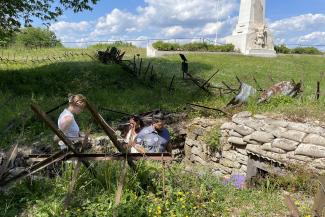
World War I is often presented in superlative terms. It was “the war to end all wars” with fatalities to match. The Battle of the Somme had the largest number of casualties in British history; The Battle of the Argonne was the largest and deadliest battle in American history. With numbers so staggering, it can be hard to remember anything else.
“What can fall out of the picture is the fact that if there were 1.2 million Americans involved in the Battle of the Argonne; each of them was a person,” says history professor Warren Breckman. “To really think about that dimension is illuminating and brings something unusual to the study of a war.”
More than 100 years after Armistice Day, Breckman and the students in the Penn Global Seminar this spring looked at World I through the intersections of personal and public memory. After spending the semester studying historical and primary literature in the form of memoirs, The Great War in Memoir and Memory seminar ended with a one-week visit in May to the Western Front area of northern France and Belgium, organized by Penn Global’s Arielle Schweber.
Although Breckman previously taught the course during the centennial of the war, this spring marked the first time it had a travel component, which brought readings to life on in the fields of Belgium and the streets of French villages. This was something the students agreed transformed their understanding of the war’s continuing effect on the places where it was fought.
Breckman comes to this topic personally. His grandfather was a Canadian soldier in World War I, a cavalry member named George Hambley who kept a journal during his service. Now totaling about 20 volumes and kept in a Manitoba archive, Hambley’s writing is considered by many historians to be among the best diaries of a Canadian soldier.
“Unlike a lot of veterans, he talked readily and incessantly about his experience,” says Breckman, who is now working on a book about his grandfather during the war.
Monuments and memory
World War I was the primordial catastrophe of 20th-century history. For those who passed through it, the war was transformative and led to an outpouring of memoirs and fictional accounts written by participants. In its wake, it also produced new forms of public commemoration and memorialization: tombs to the unknown soldier, great monuments, soldiers’ cemeteries, and solemn days of remembrance. The class looks at the war through this lens.
“I want these students to think deeply about the personal dimensions or the experiential dimensions of warfare, to understand something about the long-term consequences of war,” he says.
During the trip, the class had jam-packed days as they traveled to battlefields in the Somme region: to Verdun, to Vimy Ridge, to cemeteries, memorials and museums built by Allied nations on symbolically important ground.
But some of the most poignant moments came in spots off the beaten path, Breckman says.
“One day, we went to an out of the way American cemetery near closing time. As we were talking and looking around, a bugle starts and out comes a Frenchman who oversees the cemetery, and he lowers the American flag as this bugle was playing,” Breckman says. The caretaker invited two of the students to help fold the flag.
“We were all deeply moved by this Frenchman fulfilling his duty each day, carefully folding the American flag in a remote corner of Northern France all these years after the war’s end,” he says.
For many, the most meaningful experience of the trip came in a small village of Iwuy, where Breckman’s grandfather and his fellow Canadian cavalry men fought to liberate the town.
Read the entire story HERE
